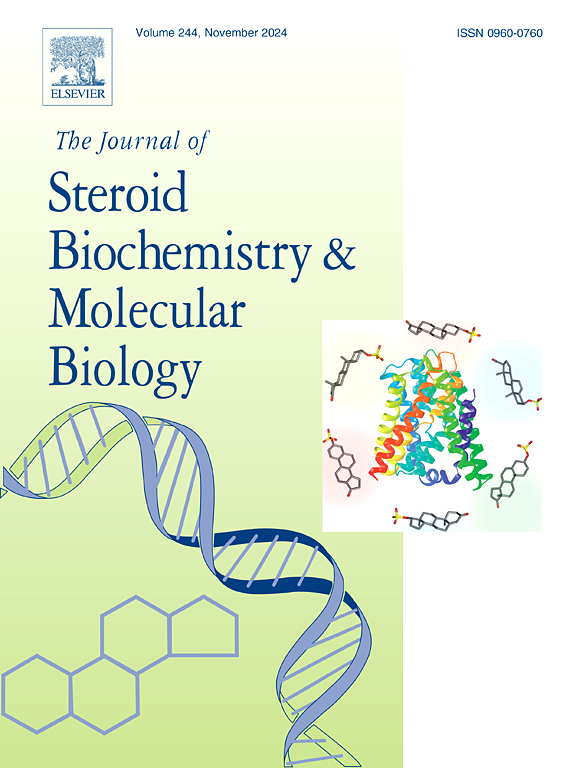1,25-二羟基维生素D3在高脂饮食小鼠模型中通过丁酸途径调节肠胶质生物活性。
IF 2.7
2区 生物学
Q3 BIOCHEMISTRY & MOLECULAR BIOLOGY
Journal of Steroid Biochemistry and Molecular Biology
Pub Date : 2024-12-06
DOI:10.1016/j.jsbmb.2024.106655
引用次数: 0
摘要
1,25-二羟基维生素D3 (1,25(OH)2D3)影响肠胶质细胞(EGCs)活性,但其机制尚不清楚。本研究旨在探讨1,25(OH)2D3是否可以通过丁酸途径调节高脂饮食模型中EGCs的活性。雄性C57BL/6J小鼠在体内分别饲喂标准日粮(SDD)、维生素d缺乏日粮(VDD)、高脂日粮(HFD)、HFD加丁酸钠(SBR)、HFD加1,25(OH)2D3、HFD加S100B抑制剂ONO-2506。体外分别用棕榈酸(PA)和油酸(OA)复合物、S100B、S100B加丁酸(BA)处理CRL-2690和Caco-2细胞。采用酶联免疫吸附法(ELISA)检测25(OH)D3、1,25(OH)2D3、TNF-α和S100B浓度。采用fitc -葡聚糖4kDa测定结肠粘膜通透性。采用高效液相色谱法检测大肠丁酸盐。结果表明,HFD降低了血清25(OH)D3和1,25(OH)2D3浓度,降低了结肠丁酸盐的生成。补充1,25(OH)2D3提高了结肠中丁酸盐的产量。添加1,25(OH)2D3和丁酸钠抑制EGCs产生S100B,降低结肠对fitc -葡聚糖的通透性。ONO- 2506抑制S100B通路降低结肠高通透性。体外实验表明,丁酸处理不仅能降低PA/ oa处理的CRL-2690细胞分泌S100B和TNF-α,还能降低S100B处理的Caco-2细胞的通透性。总的来说,1,25(OH)2D3诱导丁酸抑制EGCs的激活,这有助于防止肠屏障损伤。本文章由计算机程序翻译,如有差异,请以英文原文为准。
1,25-dihydroxyvitamin D3 regulates enteroglial bioactivity through butyric acid pathway in a high-fat diet mouse model
1,25-dihydroxyvitamin D3 (1,25(OH)2D3), affects enteric glial cells (EGCs) activity, but the mechanism is still unknown. The current study aimed to explore whether 1,25(OH)2D3 could regulate EGCs activity via butyrate pathway in a high-fat diet model. Male C57BL/6 J mice were fed with standard diet (SDD), or vitamin-D-deficient diet (VDD), or high-fat diet (HFD), or HFD plus sodium butyrate (SBR), or HFD plus 1,25(OH)2D3, or HFD plus S100B inhibitor ONO-2506 in vivo. CRL-2690 and Caco-2 cells were treated with palmitic acid (PA) and oleic acid (OA) complex, or S100B, or S100B plus butyric acid (BA) in vitro. 25(OH)D3, 1,25(OH)2D3, TNF-α and S100B concentrations were assayed by enzyme-linked immuno- sorbent assay (ELISA). Colonic mucosal permeability was measured by using FITC-dextran 4 kDa. Colonic butyrate was detected using high-performance liquid chromatography (HPLC). The results showed HFD decreased serum 25(OH)D3 and 1,25(OH)2D3 concentrations and colonic butyrate generation. 1,25(OH)2D3 supplementation raised butyrate production in the colon. 1,25(OH)2D3 and sodium butyrate supplementation inhibited EGCs to produce S100B and reduced colonic permeability to FITC-dextran. Inhibition of S100B pathway by ONO- 2506 decreased colonic hyperpermeability. In vitro experiments showed butyrate treatment not only reduced S100B and TNF-α secretion from PA/OA-treated CRL-2690 cells, but also decreased the permeability of S100B-treated Caco-2 cells. Collectively, 1,25(OH)2D3 elicited butyrate to suppress EGCs activation, which helped to prevent intestinal barrier injury.
求助全文
通过发布文献求助,成功后即可免费获取论文全文。
去求助
来源期刊
CiteScore
8.60
自引率
2.40%
发文量
113
审稿时长
46 days
期刊介绍:
The Journal of Steroid Biochemistry and Molecular Biology is devoted to new experimental and theoretical developments in areas related to steroids including vitamin D, lipids and their metabolomics. The Journal publishes a variety of contributions, including original articles, general and focused reviews, and rapid communications (brief articles of particular interest and clear novelty). Selected cutting-edge topics will be addressed in Special Issues managed by Guest Editors. Special Issues will contain both commissioned reviews and original research papers to provide comprehensive coverage of specific topics, and all submissions will undergo rigorous peer-review prior to publication.

 求助内容:
求助内容: 应助结果提醒方式:
应助结果提醒方式:


